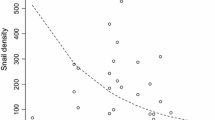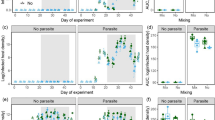Abstract
Free-living stages of parasites are consumed by a variety of predators, which might have important consequences for predators, parasites, and hosts. For example, zooplankton prey on the infectious stage of the amphibian chytrid fungus, Batrachochytrium dendrobatidis (Bd), a pathogen responsible for amphibian population declines and extinctions worldwide. Predation on parasites is predicted to influence community structure and function, and affect disease risk, but relatively few studies have explored its consequences empirically. We investigated interactions among Rana cascadae tadpoles, zooplankton, and Bd in a fully factorial experiment in outdoor mesocosms. We measured growth, development, survival, and infection of amphibians and took weekly measurements of the abundance of zooplankton, phytoplankton (suspended algae), and periphyton (attached algae). We hypothesized that zooplankton might have positive indirect effects on tadpoles by consuming Bd zoospores and by consuming phytoplankton, thus reducing the shading of a major tadpole resource, periphyton. We also hypothesized that zooplankton would have negative effects on tadpoles, mediated by competition for algal resources. Mixed-effects models, repeated-measures ANOVAs, and a structural equation model revealed that zooplankton significantly reduced phytoplankton but had no detectable effects on Bd or periphyton. Hence, the indirect positive effects of zooplankton on tadpoles were negligible when compared to the indirect negative effect mediated by competition for phytoplankton. We conclude that examination of host-pathogen dynamics within a community context may be necessary to elucidate complex community dynamics.



Similar content being viewed by others
References
Altig R, Whiles MR, Taylor CL (2007) What do tadpoles really eat? Assessing the trophic status of an understudied and imperiled group of consumers in freshwater habitats. Freshwater Biol 52:386–395
Altwegg R, Reyer HU (2003) Patterns of natural selection on size at metamorphosis in water frogs. Evolution 57:872–882
Blaustein AR, Romansic JM, Scheessele EA, Han BA, Pessier AP, Longcore JE (2005) Interspecific variation in susceptibility of frog tadpoles to the pathogenic fungus Batrachochytrium dendrobatidis. Conserv Biol 19:1460–1468
Boone MD, Semlitsch RD (2001) Interactions of an insecticide with larval density and predation in experimental amphibian communities. Conserv Biol 15:228–238
Boone MD, Semlitsch RD (2002) Interactions of an insecticide with competition and pond drying in amphibian communities. Ecol Appl 12:307–316
Boone MD, Semlitsch RD (2003) Interaction of bullfrog tadpole predators and an insecticide: Predation release and facilitation. Oecologia 137:610–616
Boyle DG, Boyle DB, Olsen V, Morgan JAT, Hyatt AD (2004) Rapid quantitative detection of chytridiomycosis (Batrachochytrium dendrobatidis) in amphibian samples using real-time Taqman PCR assay. Dis Aquat Org 60:141–148
Briggs CJ, Knapp RA, Vredenburg VT (2010) Enzootic and epizootic dynamics of the chytrid fungal pathogen of amphibians. PNAS 107:9695–9700
Brown JH, Davidson DW (1977) Competition between seed-eating rodents and ants in desert ecosystems. Science 196:880–882
Buck JC, Truong L, Blaustein AR (2011) Predation by zooplankton on Batrachochytrium dendrobatidis: biological control of the deadly amphibian chytrid fungus? Biodivers Conserv 20:3549–3553
Buck JC, Scheessele EA, Relyea RA, Blaustein AR (2012) The effects of multiple stressors on wetland communities: pesticides, pathogens, and competing amphibians. Freshwater Biol 57:61–73
Fisher MC, Garner TWJ, Walker SF (2009) Global emergence of Batrachochytrium dendrobatidis and amphibian chytridiomycosis in space, time, and host. Annu Rev Microbiol 63:291–310
Gleason FH, Kagami M, Lefevre E, Sime-Ngando T (2008) The ecology of chytrids in aquatic ecosystems: roles in food web dynamics. Fungal Biol Rev 2:17–25
Gosner KL (1960) A simplified table for staging anuran embryos and larvae with notes on identification. Herpetologica 16:183–190
Grace JB (2006) Structural equation modeling and natural systems. Cambridge University Press, Cambridge
Hamilton PT, Richardson JML, Anholt BR (2012) Daphnia in tadpole mesocosms: trophic links and interactions with Batrachochytrium dendrobatidis. Freshwater Biol 57:676–683
Han BA, Bradley PW, Blaustein AR (2008) Ancient behaviors of larval amphibians in response to an emerging fungal pathogen, Batrachochytrium dendrobatidis. Behav Ecol Sociobiol 63:241–250
Jennings DE, Krupa JJ, Raffel TR, Rohr JR (2010) Evidence for competition between carnivorous plants and spiders. Proc R Soc B—Biol Sci 277:3001–3008
Johnson PTJ, Dobson A, Lafferty KD, Marcogliese DJ, Memmott J, Orlofske SA, Poulin R, Thietges DW (2010) When parasites become prey: ecological and epidemiological significance of eating parasites. Trends Ecol Evol 25:362–371
Kagami M, Van Donk E, de Bruin A, Rijkeboer M, Ibelings BW (2004) Daphnia can protect diatoms from fungal parasitism. Limnol Oceanogr 49:680–685
Kagami M, von Elert E, Ibelings BW, de Bruin A, Van Donk E (2007) The parasitic chytrid, Zygorhizidium, facilitates the growth of the cladoceran zooplankter, Daphnia, in cultures of the inedible alga, Asterionella. Proc R Soc B 274:1561–1566
Keesing F, Belden LK, Daszak P, Dobson A, Harvell CD, Holt RD, Hudson P, Jolles A, Jones KE, Mitchell CE, Myers SS, Bogich T, Ostfeld RS (2010) Impacts of biodiversity on the emergence and transmission of infectious diseases. Nature 468:647–652
Knisely K, Geller W (1986) Selective feeding of 4 zooplankton species on natural lake phytoplankton. Oecologia 69:86–94
Lafferty KD, Dobson AP, Kuris AM (2006) Parasites dominate food web links. PNAS 103:11211–11216
Larson GL, McIntire CD, Buktenica MW, Girdner SF, Truitt RE (2007) Distribution and abundance of zooplankton populations in Crater Lake, Oregon. Hydrobiologia 574:217–233
Leibold MA, Wilbur HM (1992) Interactions between food-web structure and nutrients on pond organisms. Nature 360:341–343
Longcore JE, Pessier AP, Nichols DK (1999) Batrachochytrium dendrobatidis gen. et sp.nov., a chytrid pathogenic to amphibians. Mycologia 91:219–227
McIntire CD, Larson GL, Truitt RE, Debacon MK (1996) Taxonomic structure and productivity of phytoplankton assmblages in Crater Lake, Oregon. J Lake Reservior Manage 12:259–280
Mendelson JR, Lips KR, Gagliardo RW, Rabb GB, Collins JP, Diffendorfer JE, Daszak P, Ibanez R, Zippel KC, Lawson DP, Wright KM, Stuart SN, Gascon C, da Silva HR, Burrowes PA, Joglar RL, La Marca E, Lotters S, du Preez LH, Weldon C, Hyatt A, Rodriguez-Mahecha JV, Hunt S, Robertson H, Lock B, Raxworthy CJ, Frost DR, Lacy RC, Alford RA, Campbell JA, Parra-Olea G, Bolanos F, Domingo JJC, Halliday T, Murphy JB, Wake MH, Coloma LA, Kuzmin SL, Price MS, Howell KM, Lau M, Pethiyagoda R, Boone M, Lannoo MJ, Blaustein AR, Dobson A, Griffiths RA, Crump ML, Wake DB, Brodie ED (2006) Biodiversity. Confronting amphibian declines and extinctions. Science 313:48
Metcalfe NB, Monaghan P (2001) Compensation for a bad start: grow now, pay later? Trends Ecol Evol 16:254–260
Mokany A, Shine R (2003) Competition between tadpoles and mosquito larvae. Oecologia 135:615–620
Morin PJ, Lawler SP, Johnson EA (1988) Competition between aquatic insects and vertebrates: interaction strength and higher-order interactions. Ecology 69:1401–1409
Oregon Department of Environmental Quality (1998) Columbia Slough total maximum daily loads (TMDLs) for: chlorophyll a, dissolved oxygen, pH, phosphorus, bacteria, DDE/DDT, PCBs, Pb, dieldrin, and 2,3,7,8 TCDD. www.deq.state.or.us/wq/tmdls/docs/willamettebasin/columbiaslough/tmdl.pdf
Pace ML, Funke E (1991) Regulation of planktonic microbial communities by nutrients and herbivores. Ecology 72:904–914
Parris MJ, Beaudoin JG (2004) Chytridiomycosis impacts predator-prey interactions in larval amphibian communities. Oecologia 140:626–632
Parris MJ, Cornelius TO (2004) Fungal pathogen causes competitive and developmental stress in larval amphibian communities. Ecology 85:3385–3395
Parris MJ, Reese E, Storfer A (2006) Antipredator behavior of chytridiomycosis infected northern leopard frog (Rana pipiens) tadpoles. Can J Zool 84:58–65
Piotrowski JS, Annis SL, Longcore JE (2004) Physiology of Batrachochytrium dendrobatidis, a chytrid pathogen of amphibians. Mycologia 96:9–15
Relyea RA (2005) The impact of insecticides and herbicides on the biodiversity and productivity of aquatic communities. Ecol Appl 15:618–627
Relyea RA, Diecks N (2008) An unforeseen chain of events: lethal effects of pesticides on frogs at sublethal concentrations. Ecol Appl 18:1728–1742
Retallick RWR, Miera V, Richards KL, Field KJ, Collins JP (2006) A non-lethal technique for detecting the chytrid fungus Batrachochytrium dendrobatidis on tadpoles. Dis Aquat Org 72:77–85
Rohr JR, Crumrine PW (2005) Effects of an herbicide and an insecticide on pond community structure and processes. Ecol Appl 15:1135–1147
Rohr JR, Palmer BD (2013) Climate change, multiple stressors, and the decline of ectotherms. Conserv Biol 27:741–751
Rohr JR, Sager T, Sesterhenn TM, Palmer BD (2006) Exposure, postexposure, and density-mediated effects of atrazine on amphibians: breaking down net effects into their parts. Environ Health Perspect 114:46–50
Rohr JR, Raffel TR, Romansic JM, McCallum H, Hudson PJ (2008a) Evaluating the links between climate, disease spread, and amphibian declines. PNAS 105:17436–17441
Rohr JR, Schotthoefer AM, Raffel TR, Carrick HJ, Halstead N, Hoverman JT, Johnson CM, Johnson LB, Lieske C, Piwoni MD, Schoff PK, Beasley VR (2008b) Agrochemicals increase trematode infection in a declining amphibian species. Nature 455:1235–1240
Sanders RW, Porter KG (1990) Bacterivorous flagellates as food resources for the freshwater crustacean zooplankter Daphnia ambigua. Limnol Oceanogr 35:188–191
Schoener TW, Spiller DA (1987) Effects of lizards on spider populations: manipulative reconstruction of a natural experiment. Science 236:949–952
Seale DB (1980) Influence of amphibian larvae on primary production, nutrient flux, and competition on a pond ecosystem. Ecology 61:1531–1550
Seale DB (1982) Obligate and facultative suspension feeding in anuran larvae—feeding regulation in Xenopus and Rana. Biol Bull 162:214–231
Searle CL, Gervasi SS, Hua J, Hammond JI, Relyea RA, Olson DH, Blaustein AR (2011) Differential host susceptibility to Batrachochytrium dendrobatidis, an emerging amphibian pathogen. Conserv Biol 25:965–974
Searle CL, Mendelson JR III, Green LE, Duffy MA (2013) Daphnia predation on the amphibian chytrid fungus and its impacts on disease risk in tadpoles. Ecol Evol 3:4129–4138
Skerratt LF, Berger L, Speare R, Cashins S, McDonald KR, Phillott AD, Hines HB, Kenyon N (2007) Spread of chytridiomycosis has cause the rapid global decline and extinction of frogs. EcoHealth 4:125–134
Thieltges DW, Amundsen PA, Hechinger RF, Johnson PTJ, Lafferty KD, Mouritsen KN, Preston DL, Reise K, Zander CD, Poulin R (2013) Parasites as prey in aquatic food webs: implications for predator infection and parasite transmission. Oikos 122:1473–1482
Venesky MD, Parris MJ, Storfer A (2009) Impacts of Batrachochytrium dendrobatidis infection of tadpole foraging performance. EcoHealth 6:565–575
Venesky MD, Liu X, Sauer EL, Rohr JR (2014) Linking manipulative experiments to field data to test the dilution effect. J Anim Ecol 83:557–565. doi:10.1111/1365-2656.12159
Vredenburg VT, Knapp RA, Tunstall TS, Briggs CJ (2010) Dynamics of an emerging disease drive large-scale amphibian population extinctions. PNAS 107:9689–9694
Wake DB, Vredenburg VT (2008) Are we in the midst of the sixth mass extinction? A view from the world of amphibians. PNAS 105:11466–11473
Welschmeyer NA (1994) Fluorometric analysis of chlorophyll-a in the presence of chlorophyll-b and pheopigments. Limnol Oceanogr 39:1985–1992
Whiles M, Gladyshev MI, Sushchik NN, Makhutova ON, Kalachova GS, Peterson SD (2010) Fatty acid analyses reveal high degrees of omnivory and dietary plasticity in pond-dwelling tadpoles. Freshwater Biol 55:1533–1547
Woodhams DC, Bosch J, Briggs CJ, Cashins S, Davis LR, Lauer A, Muths E, Puschendorf R, Schmidt BR, Sheafor B, Voyles J (2011) Mitigating amphibian disease: strategies to maintain wild populations and control chytridiomycosis. Front Zool 8:8
Acknowledgments
We thank M. James, S. Moyers, L. Biga, and P. Buck for field assistance. Members of the Blaustein laboratory, E. Borer, and M. Albins provided advice regarding experimental design and execution, data analysis, and comments on the manuscript. We also thank the R. Tanguay, J. Spatafora, B. Menge, and S. Hacker laboratories, and E. Scheessele for use of equipment and protocol, and S. Robbins and D. Hinds-Cook for assistance at the Horticulture Farm. We thank J. Trexler, R. Alford, and several anonymous reviewers for insightful comments and suggestions that improved the manuscript substantially. This material is based upon work supported by the National Science Foundation Graduate Research Fellowship Program under grant no. 0802268 and a Howard Hughes Medical Institute Summer Undergraduate Research Fellowship to K. I. S. Supplementary funding was provided by the Oregon State University Zoology Research Fund and the Society of Wetland Scientists.
Conflict of interest
The authors declare that they have no conflict of interest.
Author information
Authors and Affiliations
Corresponding author
Additional information
Communicated by Ross Andrew Alford.
Rights and permissions
About this article
Cite this article
Buck, J.C., Scholz, K.I., Rohr, J.R. et al. Trophic dynamics in an aquatic community: interactions among primary producers, grazers, and a pathogenic fungus. Oecologia 178, 239–248 (2015). https://doi.org/10.1007/s00442-014-3165-6
Received:
Accepted:
Published:
Issue Date:
DOI: https://doi.org/10.1007/s00442-014-3165-6




